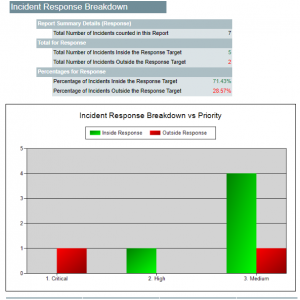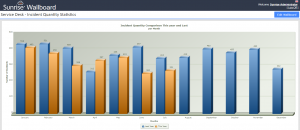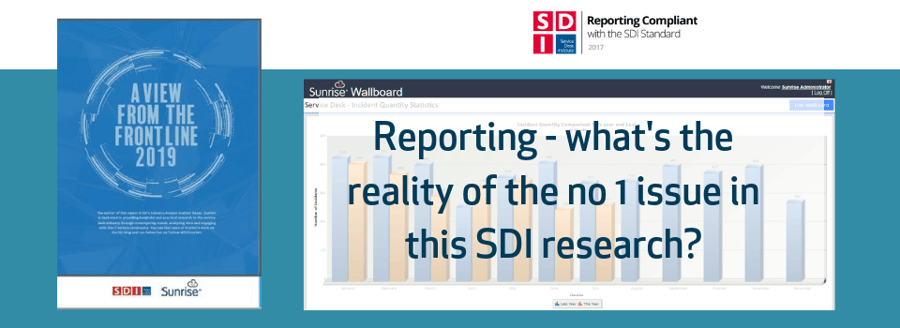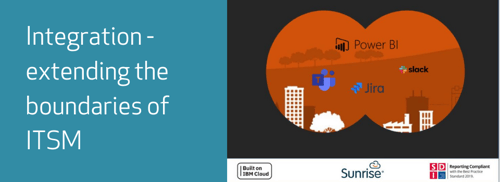Reporting in the ITSM world can be a bit hit-or-miss but is hugely important – one of the key concerns raised once again in the 2019 ‘SDI View from the Frontline report‘.
ITSM Reporting Adds Business Value
There’s so much data to work from, and so many people to inform, that quite honestly many organisations never manage to get started. They get so caught up trying to decide what to report—and to whom—that no genuine progress is ever made.
To identify your current level of reporting maturity, see if either these scenarios sound familiar to you:
Scenario #1: You spend countless hours each month producing manual reports and sending them to service managers… but you aren’t 100% sure how they are used, or if they even get read.
Scenario #2: You aren’t sure who needs what report, or how reports will be used, so you generally only produce reports when they are specifically requested.
If either of these scenarios sounds familiar, don’t panic. In our experience, this is exactly how ITSM reporting works at most organisations.
But it doesn’t have to be.
ITSM reporting can be a hugely valuable tool that helps service managers understand how their efforts affect service quality and provides the driving force for continual service improvement. It also doesn’t have to be onerous or involve hours of manual work each month to produce.
All it takes is a little planning, some communication, and the right tool for the job.
What Does Strong ITSM Reporting Look Like?
The scenarios described above represent two ends of the reporting scale, neither of which is a good basis for a reporting program. In an ideal world, organisations would find a happy medium, where a set number of finite reports are produced that provide specific—and ideally, measurable—business value.
Generally, there are two hurdles to achieving this happy medium:
1) Manual Reporting Challenges
A lot of people in the ITSM world produce reports by exporting data from their ITSM tool and manipulating it manually using Excel. This is a hugely time-consuming process and introduces all sorts of negative elements—increased likelihood of inconsistencies and human error, for a start.
So the first thing required to build an effective reporting program is simple. You need the right tool for the job. Some ITSM tools (including Sunrise) include report managers that make it easy to design reports that can then be scheduled, refreshed, downloaded, and sent in seconds.
Report managers are essential for a strong reporting program because they ensure the only driver for reporting is business value. All concern about the time required to produce complex, manual reports is removed.
Integration an analytics tool such as Power BI adds an extra dimension to Service Desk Metrics both tactically and for strategic insight.
2) Lack of Clear Reporting Goals
This is a big one. The simple reason why many organizations don’t have strong ITSM reporting programs is that they don’t have a clear understanding of what the business needs from reporting. Without this, no reporting program will ever get off the ground.
The unfortunate thing is that ITSM reporting—when it’s done well—can add huge business value. All it takes is some thoughtful planning, and a consistent, reliable, program can be developed.
What Can You Do With ITSM Reporting?
Honestly, the word “reporting” is enough to put most people to sleep. For a variety of reasons, it’s often associated with onerous, unhelpful processes that nobody benefits from.
In reality, though, reporting can be a hugely valuable asset to help improve IT services over time. Here are some of the most common ways organizations can gain genuine business value from ITSM reporting:
Identify areas for improvement — Improving service efficiency and effectiveness lies at the heart of ITIL methodology, and strong, consistent reporting is what makes it possible. Much of the time improving IT service levels is about small, regular course corrections, and there’s simply no way to identify these improvements without a strong reporting program. For example, reporting around ‘incident logged by category and problems raised’ can help to show where resource is being spent and issues are occurring. This information can then be used to help make corrective actions to reduce the likelihood of recurrence and allocate resources more efficiently.
Correlate service levels with expenditure — The relative cost of improving different IT services is often wildly different. If upping service levels in one area costs £100,000 per year but doesn’t add much business value, is it worthwhile? Clearly not. On the other hand, minimal investment in another area could add significant business value. The thing is that unless you’re consistently tracking the ROI of service improvements, you’ll never know which are truly valuable to the business.
Spot good (and bad) SLAs — SLAs are an essential part of ITSM. But what happens when they are set at the wrong level? A strong reporting program will help you understand how your IT services perform over time, making it much easier to assess how realistic your SLA targets are. If they turn out to be too high (or too low) they can always be tweaked. Simple SLA reporting could help to clearly show how you are performing against targets the business has agreed and signed up to.

Forecasting — “Predictive analytics” is the latest buzzword in the IT world, but that doesn’t mean it’s not a valuable process. When you have a strong reporting program in place over time, you’ll come to understand how your IT services perform under different circumstances. You’ll also be able to objectively measure the success of improvement initiatives, which ultimately will enable you to make better judgments about the likely impact of future initiatives. For example, simple trend reporting can help you see the volume of activity a service desk faces – including the peak times – which can be used to demonstrate not just current workload and utilisation but also help to predict and future initiatives and their likely impact.

Better Reporting with SDI Accredited ITSM
One thing we have done to help customers looking to improve their ITSM reporting is to ensure our ITSM tool is SDI accredited. You can see a short video overview—featuring our own David Bullivant—of how SDI accredited tools help organizations develop strong reporting programs over at the Service Desk Institute website.
Being accredited with SDI verifies that Sunrise ITSM is able to produce a set of specific, business-focused KPIs that the typical service desk should be tracking. There’s no rocket science here. Quite simply, by consistently reporting on these KPIs, organisations will quickly come to see how their ITSM program stacks up, and which areas (if any) are in need of improvement.
Other SDI requirements include:
- Quick and efficient display of the performance results data.
- Data is presented in a clear and concise way.
- The data must be displayed graphically, and comply with strict UX requirements.
All of this is done for one simple reason—we want to help our customers develop simple, low maintenance ITSM reporting programs that provide measurable business benefits.
To see how the Sunrise ITSM reporting module could benefit your organisation, arrange a demo today




.png)
